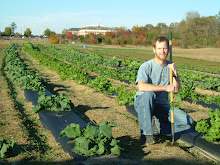A couple days ago, I spent most of the day setting up irrigation for the
Community Garden.

First, put a pressure reducer on the water tap. This reduces the pressure to 12 psi.

Next, hook up the hose line to a jimmy-rigged construction of various PVC fittings to allow a connection to the "lay-flat".

This is a roll of lay-flat. It is the central distribution line for irrigation in the field.
It must be kept in a straight line so that it won't kink when it fills up with water.

The end of the lay-flat. When you reach the end of the field, cut off the roll, leaving 2-3 feet extra so that you can fold it twice to seal off the end. Then cut off about a foot or so, which will slide onto the folded end to make a cheap cap to the end of the lay-flat.

Stuff the twice-folded end into the sleeve to form a (mostly) water-tight seal.

Next, hook up the field lines. This is done by piercing the lay-flat with a piece of polytubing. The polytube should insert all the way into the lay-flat so that it doesn't pull out when the lay-flat inflates with water. Then slip the polytube into a connector, in this case a stopcock that will allow me to shut off certain lines when i want to.

Drip tape is below the plastic mulch. Our drip tape has "emitters" that allow a drip every 12 inches.
The stopcock slides into the t-tape and seals using a screw.

The field lines.

But the end of the drip tape still isn't sealed!

This year, i wanted to put some extra land into production for growing corn. Plastic is too expensive to use on corn, so i will just grow it on bare ground. My plan is to hook up extra drip tape over the bare ground and grow the corn at each emitter.
In this case, i connect more drip tape to the end of the field lines using a connector.

The end of the drip tape can be sealed by using a cap, or more cheaply by simply folding the end and sliding it into a sleeve, as we did with the lay-flat.

A view from the north end of the field.

Turn on the irrigation, and the lay-flat balloons into a giant pressurized cylinder.

The wetting pattern can be seen here. The hoe is for scale. The advantage is that we can inject fertilizer and water directly to the crop roots, instead of broadcasting fertilizer, which will also fertilize weeds!
We can also reduce disease by keeping the leaves dry while irrigating. Overhead irrigation gets the leaves wet, which invites fungal disease. Additionally, we can reduce the amount of fertilizer and water applied since we are applying it over a smaller area.

Once the ground is wet, go ahead and start planting!
Yesterday, we planted the entire corn field, 3 rows of tomato seedlings, and 2 rows of squash, thanks to our wonderful volunteers!







































